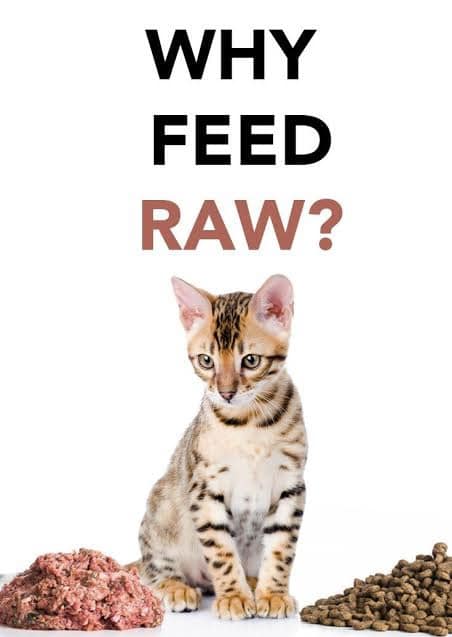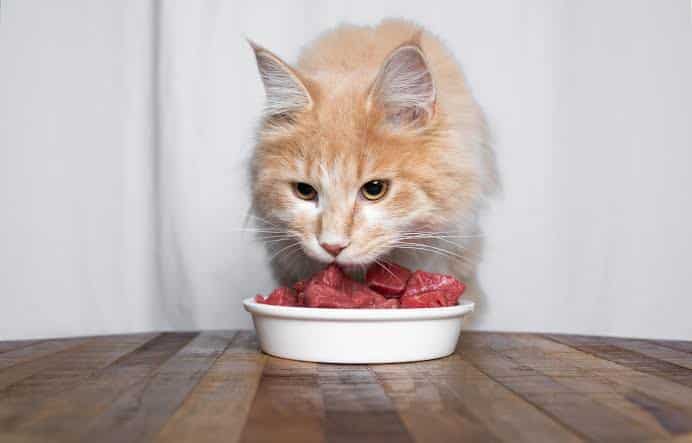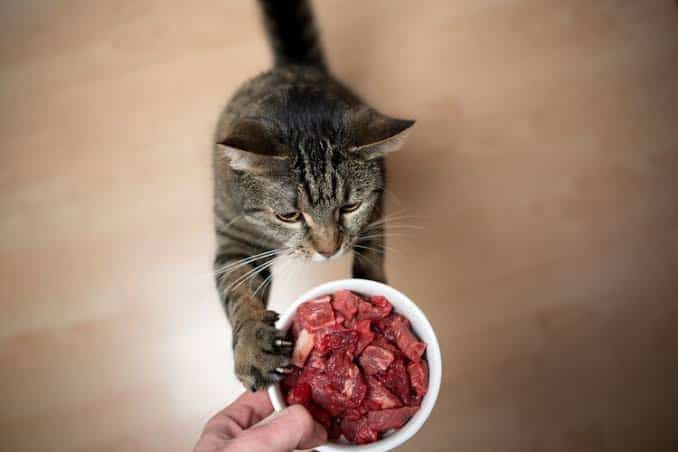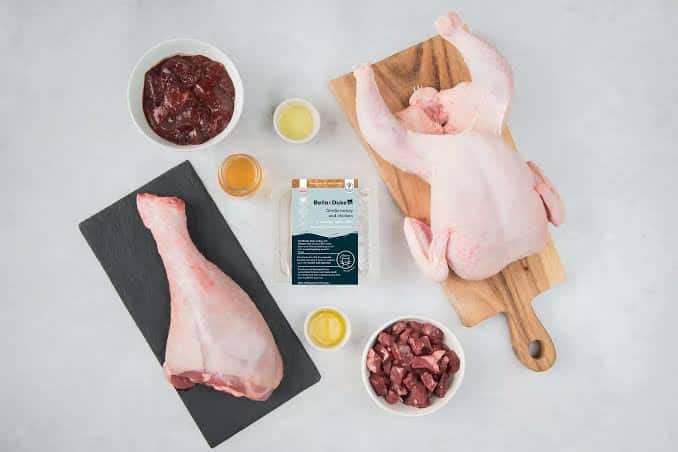Welcome to our article on “A Comprehensive Guide To Raw Cat Food”. Here, we shall delve into: What Is Raw Cat Food?, Benefits Of Raw Cat Food, Transitioning To Raw Cat Food, Raw Cat Food Safety Guidelines, etc. Also, we will touch some aspects like the potential risks, and practical tips to ensure your cat thrives on a raw food regimen.
Understanding the importance of proper nutrition is crucial for promoting the well-being and longevity of your feline friend. Let’s embark on a journey to discover the ins and outs of raw cat food and its significance in maintaining optimal health for your beloved pet.
What Is Raw Cat Food?
Raw cat food primarily consists of uncooked ingredients, mirroring the diet of a cat’s wild ancestors. It typically includes raw meat, organs, and bones, aiming to provide a diet that closely aligns with a cat’s natural nutritional needs.
Benefits Of Raw Cat Food
In the pursuit of providing optimal care for our feline friends, many pet owners are turning to a diet that closely mimics what their ancestors thrived on – raw cat food. Let’s look into the extensive benefits of embracing this natural and nutrient-rich approach, focusing on three key aspects: Improved Digestion, Healthier Coat and Skin, and Increased Energy Levels.
Improved Digestion
When it comes to feline digestion, raw cat food takes center stage. Unlike processed commercial diets, raw food retains essential enzymes and nutrients, promoting a healthier digestive system. Cats, being obligate carnivores, benefit from the biologically appropriate content of raw diets, aiding in better nutrient absorption and reducing the risk of digestive issues.
Healthier Coats And Skin
The condition of a cat’s coat and skin reflects its overall health. Raw cat food, abundant in essential fatty acids, vitamins, and minerals, contributes to a lustrous coat and supple skin. By providing the necessary building blocks for a strong immune system, raw diets address skin conditions and allergies, leaving your feline companion with a gleaming and vibrant appearance.
Increased Energy Levels
Energy levels are crucial for the well-being of your cat, especially for those who lead an active lifestyle. Raw cat food serves as a powerhouse of nutrients, supplying the energy needed for daily activities and play. With a diet rich in bioavailable nutrients, your cat can experience increased vitality, ensuring they are ready for every pounce and playful adventure.
More Information
The benefits of raw cat food extend far beyond the bowl. From supporting improved digestion to enhancing coat and skin health and boosting energy levels, this natural approach aligns with the ancestral needs of our feline companions. As you embark on this nutritional journey, remember that the keyword “Raw Cat Food” not only signifies a dietary choice but a commitment to the overall well-being and happiness of your beloved cat.

Nutritional Requirements For Cats
Embarking on the journey of providing the best care for your feline friend involves understanding their unique nutritional needs. This section explores the intricate world of cat nutrition, shedding light on essential nutrients and the importance of comprehending feline dietary requirements, with a focus on the revolutionary approach of Raw Cat Food.
Understanding Feline Dietary Needs
To meet the nutritional needs of your cat, it’s crucial to recognize the essential nutrients that contribute to their well-being. Proteins, derived from high-quality sources, are the cornerstone of a cat’s diet, supporting muscle development and overall health. Raw cat food, being rich in bioavailable proteins, ensures that your feline companion receives the building blocks necessary for a thriving life.
Essential Nutrients
Fats play a crucial role in a cat’s diet, contributing to energy, skin health, and nutrient absorption. Raw cat food, often featuring natural sources of essential fatty acids like omega-3 and omega-6, promotes a glossy coat and supports immune function. By incorporating these fats into their diet, you’re helping your cat maintain optimal health and vitality.
While cats are obligate carnivores, they can derive some benefits from moderate carbohydrate intake. Raw cat food recipes thoughtfully incorporate carbohydrates from sources like vegetables, aiding in digestion and providing additional nutrients. Striking the right balance ensures that your cat receives the necessary energy without compromising their carnivorous nature.
Micronutrients, including vitamins and minerals, are indispensable for a cat’s overall health. Raw cat food, with its minimally processed nature, preserves these essential elements, contributing to strong bones, a robust immune system, and overall well-being. Providing a varied and nutrient-rich diet ensures your feline companion receives a spectrum of micronutrients vital for their health.
DIY Raw Cat Food vs. Commercial Options
In the world of feline nutrition, the debate between raw cat food and commercial alternatives has sparked curiosity among devoted cat parents. However, we shall discuss the pros and cons of preparing raw cat food at home and the nuances of evaluating commercial raw cat food brands.
1. Preparing Raw Cat Food At Home
Pros:
- Customization: Preparing raw cat food at home allows pet owners to tailor the ingredients to meet their cat’s specific dietary needs, accommodating allergies or sensitivities.
- Quality Control: With homemade raw cat food, you have complete control over the sourcing and quality of ingredients, ensuring a wholesome and nutritious meal for your feline friend.
- Cost Savings: Crafting your own raw cat food may be more budget-friendly in the long run, especially if you can source ingredients in bulk or take advantage of local sales.
Cons:
- Nutritional Balance: Achieving the right balance of essential nutrients can be challenging, potentially leading to nutritional imbalances or deficiencies. Consultation with a veterinary nutritionist is advisable.
- Time-Consuming: Preparing raw cat food demands time and effort, from sourcing ingredients to ensuring proper food handling and hygiene. It might not be suitable for pet owners with busy schedules.
- Risk of Contamination: Raw meat poses a risk of bacterial contamination for both cats and humans. Careful handling and sanitation are crucial to minimize this risk.
2. Evaluating Commercial Raw Cat Food Brands
Pros:
- Convenience: Commercial raw cat food provides a convenient solution for pet owners who may not have the time or inclination to prepare raw meals at home. Simply thaw and serve.
- Nutrient Profiles: Reputable commercial brands invest in formulating well-balanced recipes, ensuring that your cat receives all essential nutrients in the right proportions.
- Safety Standards: Established brands adhere to stringent safety standards, minimizing the risk of bacterial contamination. Quality control measures are in place throughout the production process.
Cons:
- Cost: Commercial raw cat food can be pricier than preparing meals at home. However, some argue that the convenience and quality justify the expense.
- Limited Ingredient Control: While commercial options provide convenience, they may not cater to specific dietary restrictions or preferences your cat might have.
- Processing Methods: Processing techniques, such as high-pressure pasteurization, might alter the texture or taste of the raw ingredients, potentially affecting palatability for some cats.
Foot Note
In the ongoing saga of raw cat food choices, the decision ultimately boils down to your cat’s unique needs and your lifestyle. Whether you choose the hands-on approach of preparing raw cat food at home or opt for the convenience of commercial options, a balanced, nutrient-rich diet is key.
Keep in mind that consulting with your veterinarian is paramount to ensure your feline companion thrives on their chosen diet. Remember, the purr-fect choice is the one that aligns with both your cat’s health requirements and your practical considerations.

Transitioning To Raw Cat Food
Embarking on the journey of transitioning your feline friend to a raw cat food diet? Fear not! Here, you will find out the ins and outs of the process, offering valuable insights, tips, and solutions to make the shift as smooth as a cat’s whiskers.
The Gradual Shift
Why Go Gradual?
Transitioning your cat to raw cat food is like introducing a new dance partner—smooth and gradual steps ensure a harmonious transition.
- Start Slow: Begin by mixing a small amount of raw food with your cat’s regular diet. This slow introduction helps them acclimate to the new texture and flavor without causing a dietary shock.
- Incremental Increases: Over a period of days or weeks, gradually increase the proportion of raw cat food while decreasing their current diet. This gradual shift prevents digestive upsets and eases your cat into their new culinary adventure.
Addressing Common Challenges
Palatability Predicaments:
- Resistance to Raw Texture: Some cats may turn up their noses at the unfamiliar texture of raw food. Warm it slightly or experiment with different protein sources to find the flavor that tickles their taste buds.
- Transitioning Picky Eaters: If your feline friend is a discerning diner, try incorporating elements of their favorite treats or toppings into the raw food. This can make the transition more enticing.
Digestive Dilemmas:
- Monitor Stool Changes: A sudden shift can lead to changes in your cat’s stool. Keep a close eye on their litter box habits and, if needed, slow down the transition process to allow their digestive system to adapt.
- Introduce Probiotics: To promote a healthy gut, consider adding probiotics to your cat’s diet. This can aid digestion and ease any digestive discomfort during the transition.
Gradual Introduction Tips
Variety is the Spice of Transition:
- Experiment with Proteins: Cats are individuals with unique taste preferences. Try different protein sources like chicken, beef, or fish to find the one that resonates with your cat’s palate.
- Texture Matters: Some cats prefer ground textures, while others enjoy chunks. Tailor the texture of the raw cat food to suit your cat’s preferences.
Overcoming Challenges
Persistence Pays Off:
- Patience is Key: Transitioning to raw cat food is a journey, not a race. Be patient, and if your cat shows reluctance, take a step back and reintroduce the raw food gradually.
- Seek Professional Guidance: If challenges persist, consult with your veterinarian. They can provide tailored advice based on your cat’s health, addressing any specific concerns during the transition.

Raw Cat Food Safety Guidelines
Embarking on the raw cat food journey? Ensuring the safety of the raw ingredients is paramount for your feline friend’s well-being. Here are the comprehensive guidelines on handling and storing raw ingredients, minimizing risks, and creating a safe culinary haven for your beloved pet.
Handling Ingredients With Care
Selecting Quality Ingredients:
- Source Wisely: Opt for high-quality, fresh ingredients from reputable suppliers. Ensuring the raw meat, organs, and bones are of top-notch quality forms the foundation of a safe raw cat food diet.
- Inspect Thoroughly: Before purchasing, inspect raw ingredients for any signs of discoloration, off odors, or abnormal textures. If something seems amiss, err on the side of caution and choose alternative sources.
Storing Raw Ingredients
Temperature Matters:
- Refrigeration Basics: Raw ingredients, especially meat, should be stored in the refrigerator at temperatures below 40°F (4°C) to inhibit bacterial growth. Use a dedicated container to prevent cross-contamination.
- Freezing for Safety: If you’re not using the raw ingredients immediately, freezing is a reliable method to preserve freshness. Ensure proper packaging to prevent freezer burn and maintain nutritional integrity.
Minimizing Contamination Risks
Safe Food Handling:
- Separation is Key: Avoid cross-contamination by keeping raw cat food ingredients separate from human food. Use dedicated utensils, cutting boards, and preparation surfaces to minimize the risk of bacterial transfer.
- Hand Hygiene: Wash your hands thoroughly after handling raw ingredients. Consider using disposable gloves to further reduce the risk of bacterial transmission.
Hygienic Preparation Of Raw Cat Food
Hygienic Preparation:
- Clean and Disinfect: Before preparing raw cat food, ensure your kitchen surfaces and utensils are clean and disinfected. Regularly clean feeding bowls and utensils used for your cat’s meals.
- Controlled Environment: Prepare raw cat food in a controlled environment to minimize the risk of contamination. Consider designating a specific area in your kitchen solely for raw cat food preparation.

Common Concern About Raw Cat Food
One prevailing concern revolves around the potential for bacterial contamination in raw cat food. While it’s crucial to handle raw meat with care, reputable commercial raw cat food manufacturers adhere to stringent safety standards, minimizing the risk of harmful bacteria. Proper storage, handling, and sourcing of ingredients play pivotal roles in ensuring the safety of raw cat food.
Sample Raw Cat Food Recipes
Let’s explore some sample raw cat food recipes that not only cater to your cat’s taste buds but also contribute to their overall well-being.
The Importance Of Balanced Nutrition
Ensuring your cat receives a balanced diet is crucial for their health. Raw cat food offers a plethora of nutrients that can be easily assimilated by your feline friend. A well-balanced meal typically includes protein, fats, vitamins, and minerals in appropriate proportions.
Sample Raw Cat Food Recipes
- Chicken Delight:
- Ingredients: Raw chicken chunks, finely ground bones, and chicken liver.
- Method: Combine the ingredients in a ratio that ensures a balanced nutritional profile. Serve it fresh to provide your cat with essential proteins and healthy fats.
- Fish Fusion:
- Ingredients: Fresh fish fillet, fish oil, and a touch of finely ground vegetables.
- Method: Mix the ingredients to create a delectable fish-based raw meal. Rich in omega-3 fatty acids, this recipe supports your cat’s skin and coat health.
- Beef Bonanza:
- Ingredients: Raw beef, beef liver, and a sprinkle of powdered eggshell for added calcium.
- Method: Blend the ingredients to perfection, offering your cat a protein-packed meal that supports muscle development.
Tips For Variety In A Cat’s Diet
- Rotate Protein Sources:
- Introduce variety by rotating protein sources. This prevents dietary imbalances and keeps your cat interested in their meals.
- Include Organ Meats:
- Incorporating organ meats like liver provides essential nutrients such as vitamins A and B12, crucial for your cat’s health.
- Add Supplemental Ingredients:
- Consider adding supplements like taurine to ensure your cat receives all the necessary nutrients for optimal health.
Frequently Asked Questions
Why consider a raw cat food diet?
Raw cat food diets aim to mimic a cat’s natural, ancestral diet, promoting overall health, improved coat condition, and dental health.
What does a raw cat food diet typically consist of?
A balanced raw cat food diet includes meat, organs, and bones, ensuring essential nutrients like protein, fat, vitamins, and minerals.
Is a raw cat food diet suitable for all cats?
While many cats thrive on raw diets, it’s crucial to consult with a veterinarian to ensure it meets your cat’s specific health needs.
How do I transition my cat to a raw food diet
Gradual transition is key. Start by mixing small amounts of raw food with your cat’s current diet and gradually increase the ratio over a week or two.
Can I make raw cat food at home?
Yes, but it requires careful planning to meet nutritional needs. Consult a veterinary nutritionist or use reputable recipes to ensure a balanced diet.
Are there risks associated with raw cat food?
There are potential risks, such as bacterial contamination. Proper handling, storage, and sourcing quality ingredients help minimize these risks.
Conclusion
As you embark on the raw cat food journey, we encourage you to embrace the health benefits and joy it can bring to your cat’s life. Raw cat food isn’t just a trend; it’s a holistic approach to feline well-being.
By incorporating these nutritious recipes and tips, you’re not only providing your cat with a tasteful experience but also supporting their overall health – from gleaming coats to robust immune systems. Take a step beyond conventional diets and let your feline friend thrive on the raw goodness that nature intended.
Remember, each cat is unique, so don’t hesitate to experiment with different recipes to find the perfect fit. Your cat’s well-being is the ultimate reward, and exploring raw food options is a step towards ensuring they lead a happy and healthy life.
In conclusion, the world of raw cat food awaits – a world where nutrition meets delight. Here’s to nourishing your feline friend with the best that nature has to offer. Dive into the realm of raw cat food and witness the transformation in your cat’s vitality, one wholesome meal at a time.
